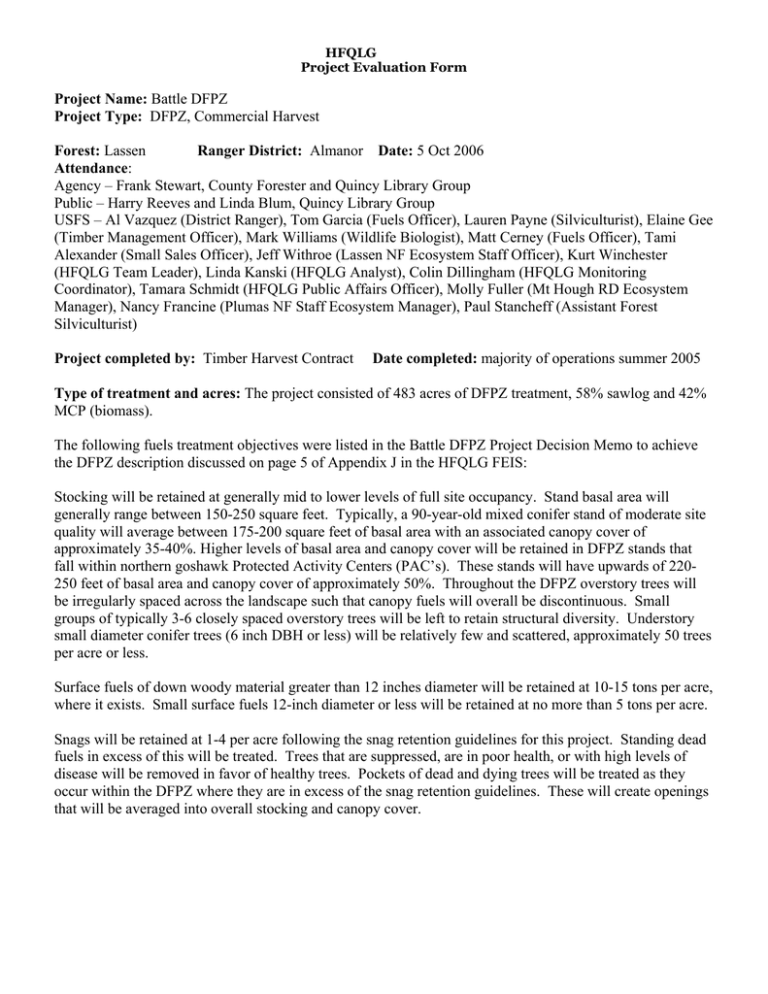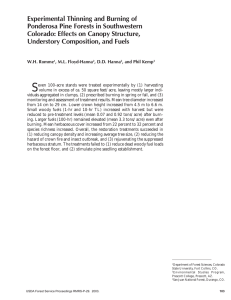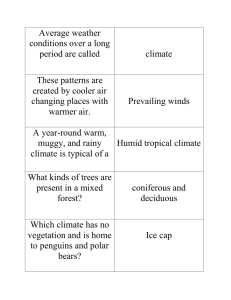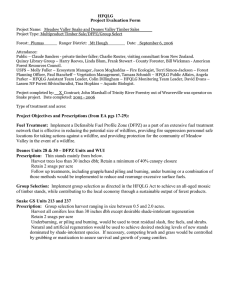Project Name: Project Type: Forest: Ranger District:
advertisement

HFQLG Project Evaluation Form Project Name: Battle DFPZ Project Type: DFPZ, Commercial Harvest Forest: Lassen Ranger District: Almanor Date: 5 Oct 2006 Attendance: Agency – Frank Stewart, County Forester and Quincy Library Group Public – Harry Reeves and Linda Blum, Quincy Library Group USFS – Al Vazquez (District Ranger), Tom Garcia (Fuels Officer), Lauren Payne (Silviculturist), Elaine Gee (Timber Management Officer), Mark Williams (Wildlife Biologist), Matt Cerney (Fuels Officer), Tami Alexander (Small Sales Officer), Jeff Withroe (Lassen NF Ecosystem Staff Officer), Kurt Winchester (HFQLG Team Leader), Linda Kanski (HFQLG Analyst), Colin Dillingham (HFQLG Monitoring Coordinator), Tamara Schmidt (HFQLG Public Affairs Officer), Molly Fuller (Mt Hough RD Ecosystem Manager), Nancy Francine (Plumas NF Staff Ecosystem Manager), Paul Stancheff (Assistant Forest Silviculturist) Project completed by: Timber Harvest Contract Date completed: majority of operations summer 2005 Type of treatment and acres: The project consisted of 483 acres of DFPZ treatment, 58% sawlog and 42% MCP (biomass). The following fuels treatment objectives were listed in the Battle DFPZ Project Decision Memo to achieve the DFPZ description discussed on page 5 of Appendix J in the HFQLG FEIS: Stocking will be retained at generally mid to lower levels of full site occupancy. Stand basal area will generally range between 150-250 square feet. Typically, a 90-year-old mixed conifer stand of moderate site quality will average between 175-200 square feet of basal area with an associated canopy cover of approximately 35-40%. Higher levels of basal area and canopy cover will be retained in DFPZ stands that fall within northern goshawk Protected Activity Centers (PAC’s). These stands will have upwards of 220250 feet of basal area and canopy cover of approximately 50%. Throughout the DFPZ overstory trees will be irregularly spaced across the landscape such that canopy fuels will overall be discontinuous. Small groups of typically 3-6 closely spaced overstory trees will be left to retain structural diversity. Understory small diameter conifer trees (6 inch DBH or less) will be relatively few and scattered, approximately 50 trees per acre or less. Surface fuels of down woody material greater than 12 inches diameter will be retained at 10-15 tons per acre, where it exists. Small surface fuels 12-inch diameter or less will be retained at no more than 5 tons per acre. Snags will be retained at 1-4 per acre following the snag retention guidelines for this project. Standing dead fuels in excess of this will be treated. Trees that are suppressed, are in poor health, or with high levels of disease will be removed in favor of healthy trees. Pockets of dead and dying trees will be treated as they occur within the DFPZ where they are in excess of the snag retention guidelines. These will create openings that will be averaged into overall stocking and canopy cover. Resource Area Attribute Objective Marking guidelines for prescription B Overall effective, a little high some units. Thin stand to achieve 35-50% canopy cover (Decision Memo) Decision Memo and Marking Guidelines for prescription B and prescription C Met guidelines, exceeded minimum canopy requirements. Marking Guidelines Successful Decision Memo Successful Basal area Silviculture/ Wildlife Canopy cover Wildlife Stand heterogeneity Maintain all size classes and species in stand Wildlife Snag Management Maintain 1-4 snags per acre Riparian area management Maintain 100 foot buffer on intermittent streams Fuels DFPZ treatment Reduce ladder fuels and canopy fuels Soils Soil Compaction and disturbance Prevent deleterious soil compaction and reduce surface disturbance. Residual stand damage Prevent excess damage to residual trees during harvest Sale Administration Heritage/ Botany Degree Met Thin to retain generally 150-200 square feet basal area Silviculture Riparian Habitat Source of Objective Decision Memo HFQLG FEIS Appendix J and Decision Memo Contract contract Yes Successful Successful, no apparent compaction observed and little soil disturbance. Successful Comments Post-treatment monitoring in units 72 and 74 had 177 and 231 ft2 basal area, respectively Post-treatment monitoring in units 72 and 74 had 37% and 58% canopy cover respectively, using densitometer Stand contained trees from saplings to oldgrowth pine and produced a fire-safe heterogeneous stand. Post-treatment monitoring in units 72 and 74 had 2-3 snags per acre (> 15” dbh) respectively No mechanical disturbance within RHCA, only hand treatment. Canopy fuels and ladder fuels greatly reduced and meet objectives for effective DFPZ, follow-up underburn planned to treat surface fuels. Operator was careful with equipment and little soil displacement was observed. Little residual damage observed. No issues discussed Shortcomings and Successes: The project was an economic success and produced an effective DFPZ. All present were pleased with the successful DFPZ implementation. Retaining 2-3 snags per acre in a stand with this many trees removed is a recognizable accomplishment. Kudos were given to the district, sale administrator and operator. Hazard trees identified by CalTrans were included in the project. District Ranger Al Vazquez proposed that the district would no longer include the removal of hazard trees within HFQLG projects to avoid potential misunderstandings regarding the objectives for HFQLG projects versus hazard tree removal. Frank Stewart strongly opposed this proposal because of the potential economic loss of removing the hazard trees and the increased large wood that would be present in the DFPZ. No decision was finalized. Follow up actions: Frank Stewart suggested that the USFS should consider using stewardship contracts in project of this size. Funds could be used to enhance the adjacent campgrounds or to remove hazards. District Ranger: _/s/ Alfred G. Vazquez__________________ Date: November 6, 2006___________





